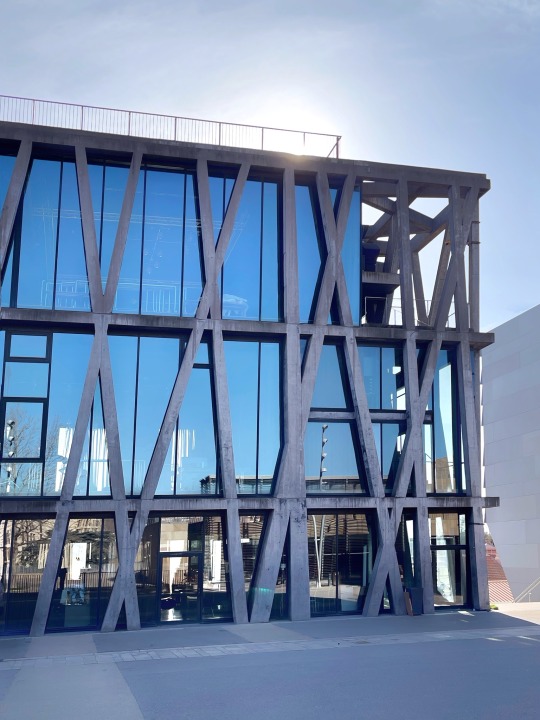#Conservatoire
Text

Idk what theyve done to me but im posessed. I need to draw them
#love love love dark skinned marceline#harder to convey that shes pasty#but oh well#she slays anyways#shes wearing silver jewelery on purpose i like my irony#anyways shes studying in a whats it called#conservatoire#how do you say it in english#where you study music#and bubblegum is doubling in chem and physics like the stem kid she is#theyre both nerds#bubbline uni au is all my brain can think of atm#my flu riddled brain can only muster 'they study together' through the haze#im sick as a dog btw#my nose dripped the entire time i was scribbling this out#actually awful#worst feeling#but we live love laugh for bubbline#bubbline#princess bubblegum#marceline the vampire queen#bubblegum x marceline#adventure time#wlw#chiquilines draws
968 notes
·
View notes
Text

Bordeaux, mai 2024
#photography#photographie#photograph of tumblr#france#bordeaux#cityscape#buildings#walls#brutalist#public transport#conservatoire#angles#architecture#memoria#memorabilia
9 notes
·
View notes
Photo

12.10.2022
“There's a limit to your love
Like a waterfall in slow motion
Like a map with no ocean
There's a limit to your love
Your love, your love, your love
There's a limit to you care
So carelessly there, is it truth or dare?
There's a limit to your care”
#284of365
#ivy#autumn ivy#poznan#poison ivy#red ivy#gothic#wednesday#wensday#gothic architecture#music of school#nevermore#conservatoire#james blake#limit to your love
12 notes
·
View notes
Text
Après des années, je me lance.
J'intègre le conservatoire de musique pour jouer de l'alto. 🎻
J'avais l'impression hier, lors de cet essai, de ne faire qu'un avec l'instrument. Il est, à lui tout seul, une entité qui me complète.
Une relation très intime entre l'alto et moi même comence. 🎼
5 notes
·
View notes
Text

OTD in Music History: Hector Berlioz (1803 – 1869) is born in France. One of the greatest of the early Romantic composers – and the first great composer in history who was not also a proficient instrumentalist! – he learned a little guitar from his physician father in his early years, and then later studied composition at the Paris Conservatoire (after dropping out of medical school to the dismay of his parents). His first great score was the famous “Symphonie fantastique” (1830), and his other major works include the operas “Benvenuto Cellini” (1837), “Les Troyens” (1858), and “Beatrice et Benedict” (1862); the program symphonies “Harold en Italy” (1834) and “Romeo et Juliette” (1839); and the choral dramas “La Damnation de Faust” (1846) and “L’Enfance du Christ” (1854). Berlioz was also one of the greatest music critics in history and one of the most important conductors of his day, and his “Treatise on Orchestration” (1843) is arguably the single most influential work of its kind ever written.
PICTURED: A fair copy – written out by Berlioz in his own hand – of a celebrated letter that he received from violinist and composer Niccolo Paganini (1782 – 1840) shortly after Paganini first heard “Harold en Italie” (which he had previously commissioned from Berlioz) at a Parisian concert in December 1838. Paganini was so moved by the performance that after the concert he knelt before Berlioz in a gesture of public homage, and, two days later, he sent Berlioz this letter.
Translation:
“My dear friend, Beethoven is dead, there was no one but Berlioz who could bring him back to life; and I who have experienced your divine compositions worthy of a genius such as yours, believe it is my duty to beg you to be willing to accept as a sign of my homage 20,000 francs which will be handed over to you by the Baron of Rothschild on presentation of the enclosed note.
Believe me to be ever your affectionate friend,
Nicolo Paganini
Paris 18 December 1838”
#Hector Berlioz#composer#Mélodies#Metropolitan Opera#Opéra national de Paris#English National Opera#bel canto#opera#sonata#Symphony#student#Conservatoire#Conservatoire student#Paris Conservatoire#Paris Opera#Opéra Paris#Opéra#Opéra-Comique#University of Paris#Romantic period#Romantic era#Romanticism#music history#Classical#Classical music#Romantic music#Medical student#classical composer#Romantic composer#orchestra
5 notes
·
View notes
Text
🎻💫 APRIL NEWS: Disney, DBR + Paola Prestini, & Lincoln Center. Plus: filming, Fontainebleau Centennial, PAC NYC, and a new musical 🎵

#solo violin#solo violinist#singer songwriter#actress#disney#Daniel Bernard Roumain#DBR#Jeff McMahon#Paola Prestini#National Sawdust#Brooklyn#NYC#brooklyn nyc#PAC NYC#DBR Lab#Fontainebleau#fontainebleau castle#fontainebleau schools#fontainebleau conservatoire#fontainebleau conservatory#conservatory#chateau#fontainebleau chateau#conservatoire#bloomberg originals#bloomberg#new music#live music#composer#compositions
0 notes
Text
Conservatoire de musique du Saguenay
Évènement bénéfice Du Conservatoire à Québec Issime, le 19 mars prochain
Continue reading Conservatoire de musique du Saguenay

View On WordPress
#arts#évènement bénéfice#cms#conseil#conservatoire#fondation#lettres#manchette#musique#québec#quéec issime#saguenay
0 notes
Photo

Le Duo Cziffra au Conservatoire Francois Mitterrand, première fois a île Maurice , Mauritius , Masterclasses a Maurice , Port Louis # conservatoire # Maurice# portlouis# 4 mains# duo Cziffra# 4 mains # masterclasses# Masterclasses#piano4mains#conservatoire#masterclasses #piano4mains#concerts # (à Port Louis, Mauritius) https://www.instagram.com/p/Cog5DoIjYYV/?igshid=NGJjMDIxMWI=
0 notes
Text





Being silly at the Royal Conservatoire of Scotland
#scotland#glasgow#royal conservatoire of scotland#David tennant#ncuti gatwa#sam heughan#alan cumming#doctor who#Shakespeare in london
70 notes
·
View notes
Text



Léo Weber | Conservatoire de Paris Cnsmdp | Photos by Ferrante Ferrant
#léo weber#pointe shoes#boyonpointe#boy on pointe#ballet boy#balletboy#conservatoire de paris cnsmdp
47 notes
·
View notes
Text






OTD in Music History: The first class of 351 students enrolls at the newly founded Paris Conservatoire in 1796.
In addition to being one of the oldest and most famous conservatories, the Conservatoire also helped to foster one of the most important performance traditions in history.
In 1828, a violin professor and conductor named Francois Habeneck (1781 - 1849) founded the “Orchestra de la Societe des Concerts du Conservatoire,” which thereafter held concerts in the central hall of the Conservatoire almost continuously until 1945. It is difficult to overstate how important Habeneck and this orchestra were in the development of the art of conducting, and indeed in the codification of a modern public orchestral performing tradition. The orchestra consisted of professors of the Conservatoire and their pupils, and Habeneck formed it with one goal in mind: to regularly rehearse and flawlessly perform the symphonies of Ludwig van Beethoven (1770 – 1827). In its early years, this was likely the only ensemble in the world that was capable of executing those masterpieces at a level that would be deemed acceptable to modern ears.
A young Richard Wagner (1813 – 1883) was blown away when he heard Habeneck lead his orchestra – he later wrote that its concert series was "the only thing in Paris worthy of the attention of a musician," and recalled that a performance of Beethoven’s Ninth Symphony in 1840 “caused the scales to fall from his eyes." Wagner credited Habeneck with discovering the "true" interpretation of that key work, “because he took infinite pains to get his orchestra to understand and thus the orchestra made it sing.”
As if helping to establish Beethoven as a fixture in the concert house and inspiring Wagner (one of the most important conductors of the 19th Century) was not enough, Habeneck also led the world premiere one of the great masterpieces of the age: Hector Berlioz’s “Symphonie Fantastique” (1830).
PICTURED: A series of original programs from the orchestra’s 1843 season.
#Paris Conservatoire#Orchestra de la Societe des Concerts du Conservatoire#Conservatoire#Ludwig van Beethoven#Richard Wagner#Ninth Symphony#Hector Berlioz#orchestra#program#Symphonie Fantastique#opera#bel canto#classical music#music history
1 note
·
View note
Text
youtube
Mão na Mão by Ana Lua Caiano, live at the Conservatoire de Rennes Auditorium in Rennes, France, during Trans Musicales 2023
#music#portuguese music#ana lua caiano#kexp#live on kexp#conservatoire de rennes#trans musicales 2023#trans musicales#Youtube
22 notes
·
View notes
Text
youtube
L'invitée, a short animation by Mélina Ienco, Faustine Merle, Marie Toury, Chloé Van Becelaere, Camille van Delft, Elodie Xia
#video#animation#short film#gobelins#mélina ienco#melina ienco#faustine merle#marie toury#chloé van becelaere#elodie xia#chloe van becelaere#conservatoire paul dukas#camille van delft#conservatoire du 12e paul dukas#école nationale supérieure louis lumière#ecole louis lumière#Youtube
44 notes
·
View notes
Text

#Laetitia Bouffard-Roupe#bodies that pop#images that pop#female muscle#Ballet#Dancer#laetitiamodel.com#Paris Opera School#Conservatoire National Supérieur de Lyon#Aerial Acrobatics#National Ballet of Nancy#Festspielhaus#Jean-Ann Ryan.#International Circus Festival
11 notes
·
View notes
Text

Cover art of Ravel’s Pavane pour une infante défunte (1900)
Pavane pour une infante défunte (Pavane for a Dead Princess) is a work for solo piano by Maurice Ravel. It was written in 1899 while the French composer was studying at the Conservatoire de Paris under Gabriel Fauré. Ravel dedicated the Pavane to his patron, the Princesse de Polignac.
It was first published by Eugène Demets in 1900. In 1910 Ravel published an orchestral version with two flutes, an oboe, two clarinets, two bassoons, two horns, harp and strings.
#maurice ravel#music#classical music#piano music#Pavane pour une infante défunte#Conservatoire de Paris#Gabriel Fauré#paris#france#sheet music#graphic design#Art Nouveau
7 notes
·
View notes
Text



Le Pavillon Noir de Rudy Ricciotti dirigé par Angelin Preljolcaj et le Conservatoire Darius Milhaud de Kenzo Kuma à Aix en Provence…
#photography#original photography#original photography on tumblr#provence#aix en provence#Ricciotti#le Pavillon noir#le conservatoire#angelin preljocaj
17 notes
·
View notes